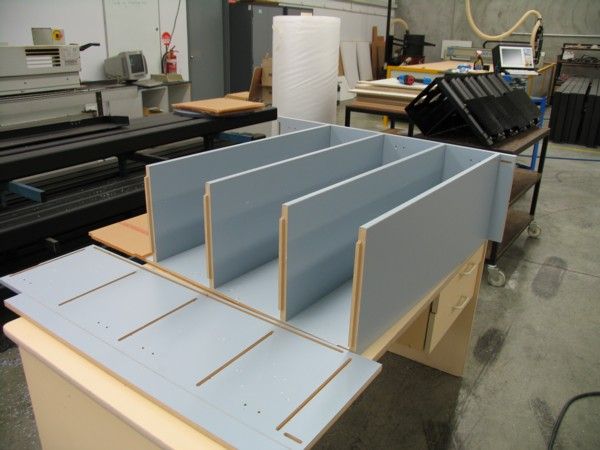Dadoed Carcase Joinery
Cabinetmakers discuss using dado joinery for cabinet assembly. October 11, 2007
Question
Our cabinet installations are all done using RTA carcasses, and we've become accustomed to the dowel-plus-confirmat-screw type of joinery. All we need on site at cab makeup time is a pair of cordless impact drivers, and a few hand tools. We are considering a move to the blind dado method, in which the supplier rebates ends and mortises sides, so that case construction goes as seen in the picture below. If you're experienced with this, tell us what the method is for fixing. Glues? Applicators? Fasteners? Tools?

Click here for higher quality, full size image
Forum Responses
(Cabinetmaking Forum)
From contributor F:
With that much joinery, you won't need much. Some aliphatic resin glue and 1.5" staples would be pretty tough on their own. Add some screws and it will be bulletproof.
From contributor A:
Contributor F's response is exactly our construction method, except we fully dado/rabbet and flush mount. We primarily use pre-finished ply. 1/4" dadoes flush 1/2" back. A little glue and 18 gauge 1 1/2" staples.
From contributor I:
That is how we have switched to doing it and the cabinets go together very fast and alignment is perfect. The only thing to watch out for is that you make sure the panel with the tab is facing the correct direction. If you flip it by mistake, the opening is going to be wrong.
From contributor J:
We're on a similar system. Using screws on unfinished sides allows you to manhandle the boxes as soon as they come off the bench. We clamp units with finished sides and wait for the glue to dry. If you finish the boxes with applied gables (as we do when the exterior finish is different from the interior), you can screw all units and be done. I think it's the fastest and strongest assembly method for euro boxes.
From contributor M:
Why are you not just making the dadoes on your upright cabinet members wide enough to accept the full thickness of your shelves? That is more the classic way to do the dado-in method. You just use a joiner to make the front edge of your shelves narrower than the bodies.
I can see how the spline you insert into the edge of the shelves and into the dadoes in the uprights eliminates the joiner step, but the shelves are not as strong that way as they would be if they were inserted into a full-thickness dado. Also, I find that inserting the full shelf thickness into a dado (I use 1/8" deep dadoes) allows all saw chipping on the shelves to be covered up. This is especially helpful in melamine, which is difficult to cut chip free.
From contributor J:
Contributor M, the short answer to all the questions you ask is - because the joints are cut on a CNC. The long answer is - there are no chips, material thickness is an issue and effective use of tooling has to be considered, in box construction upper floors finish flush with the bottom edge of the gables, fixed shelves are screwed through the back for plenty of strength.
From contributor M:
I can see how using the spline standardizes the shelf dadoes at one width rather than having to adjust them for different shelf thicknesses. Makes a lot so sense.
